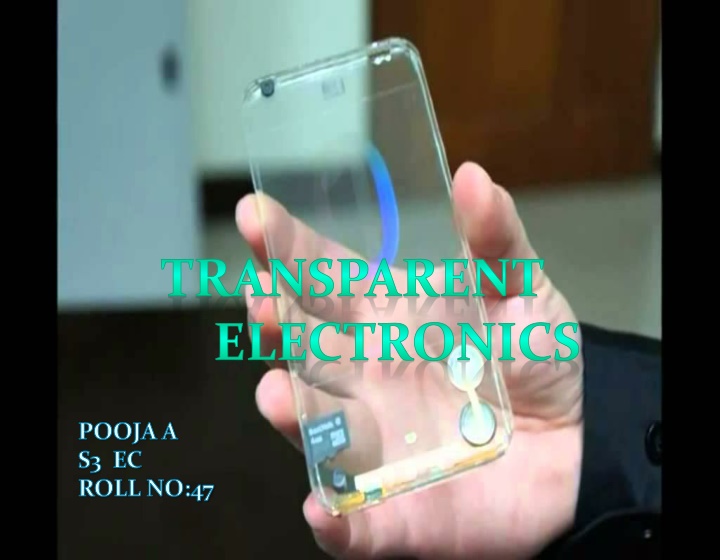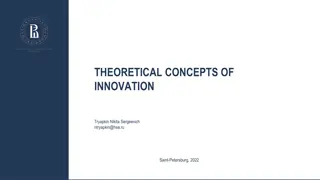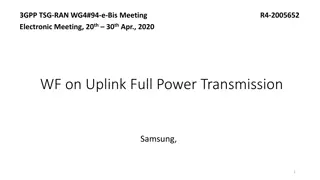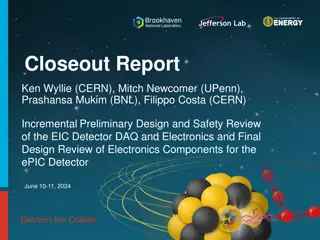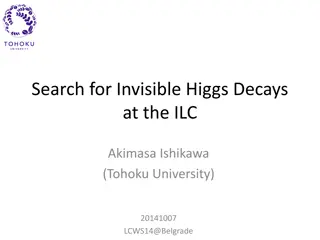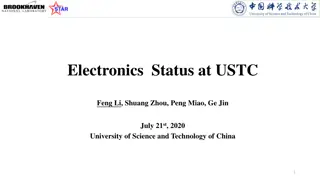Transparent Electronics and TCOs - Invisible Innovation
Invisible electronics utilizing transparent conducting films, combining optical transparency with electrical conductivity in TCOs. Learn about the factors affecting adverse effects and the electrical and optical properties of TCOs.
Download Presentation

Please find below an Image/Link to download the presentation.
The content on the website is provided AS IS for your information and personal use only. It may not be sold, licensed, or shared on other websites without obtaining consent from the author.If you encounter any issues during the download, it is possible that the publisher has removed the file from their server.
You are allowed to download the files provided on this website for personal or commercial use, subject to the condition that they are used lawfully. All files are the property of their respective owners.
The content on the website is provided AS IS for your information and personal use only. It may not be sold, licensed, or shared on other websites without obtaining consent from the author.
E N D
Presentation Transcript
TRANSPARENT ELECTRONICS POOJA A S3 EC ROLL NO:47
INTRODUCTION Invisible electronics Implemented using transparent conducting films Inorganic films are composed of TCOs Organic films are composed of carbon nanotube networks and graphene Employs wide band gap semiconductors Applications include transparent LCD,OLED and solar cell
TRANSPARENT CONDUCTING OXIDES(TCO) Doped metal oxides Examples are indium oxide,tin oxide,zinc oxide and cadmium oxide They should have more than 80% transmittance in the visible region and conductivity higher than 1000 S/cm Mobility is limited by ionized impurity scattering Most commonly used TCO at present is tin doped indium oxide. Binary compounds of metal oxides without any impurity doping have also been developed for use as TCOs.
COMBINING OPTICAL TRANSPARENCY WITH ELECTRICAL CONDUCTIVITY TCOs possess two contradictory physical properties -high optical transparency -high electrical conductivity For combining optical transparency with electrical conductivity there are two ways: -degenerate doping -Burstein-Moss shift Degenerate doping provides high mobility of electrons due to their small effective mass and low optical absorption Burstein-Moss shift helps in broadening the optical transparency window
FACTORS CAUSING ADVERSE EFFECT The large carrier concentrations required for good conductivity can cause an increase of optical absorption due to -Inter-band transitions at short wavelengths -Intra-band transitions at long wavelengths Plasma oscillations affect optical properties by reflecting electromagnetic waves of frequency below that of plasmon Ionized impurity scattering affects charge transport
ELECTRICAL AND OPTICAL PROPERTIES OF TCO Strong interactions between metal ns and oxygen 2p orbitals give rise to band structure similar for all oxides Valence band formed by oxygen 2p interactions Conduction band formed by Ms-Op interactions TCO thin films should have very low absorption coefficient The optical properties,i.e,transmission,reflection and absorption are determined by refractive index,band gap and geometry
CARRIER GENERATION There are two methods: Substitutional doping Doping with group III,IV amd VII elements Considering shrinkage of the lattice,optical band gap width,charge density distribution and electron velocity the trend is In>Y>Sc>Ga Oxygen reduction Removal of oxygen atom from a metal oxide If the free energy of formation is high oxygen vacancies create F centres else they become free carriers Result in higher carrier densities but limits mobility
CNTs Transparent conductors are fragile and tend to breakdown due to fatigue and hence CNTs are used as an alternative They have high elastic modulus,high tensile strength and high conductivity CNTs have a transmittance of more than 90% in the IR range.Hence they can be used as heat dissipators in solar cells.
APPLICATIONS Transparent laptop Transparent washer Transparent solar panel Transparent mobile
